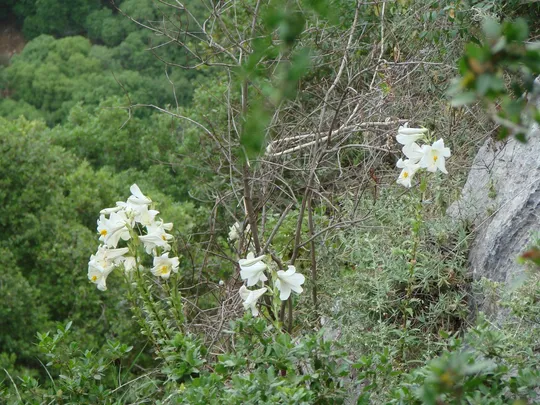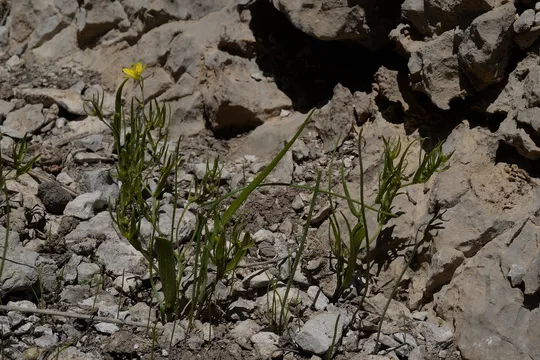Madonna Lily
Lilium candidum



Lilium candidum grows in the
Upper Galilee and on the Carmel at 20 sites, although it can be assumed that
due to the difficult access to some of the cliff sites, there are additional
sites and the estimated total is 23 sites. On the northern and western Carmel
cliffs there are 15 known sites. In the Upper Galilee L. candidum
is is found in two sections – the Kziv Stream in the Western Galilee and on the
Peki’in Ridge on the Galilee peaks (details –
Cohen and Schmida, 1991). The plant has not been found so far on the Hermon. L. candidum was collected for the first time in Israel in
1925 – by Naftolsky and Eig on the walls of a deep karst pit on the Peki’in
Ridge (Eig, 1926). This
botanical find created a great deal of excitement among biblical scholars as
well as in the Christian world. During the 1940s Tuvia Kushnir identified the species
for the first time on the Carmel.
Open rocky
habitats at the foot of limestone cliffs and occasionally on the broken cliff
sections jutting out of dense woodland in mountainous areas with an annual precipitation
above 600 mm. The leaf rosette also grows in shaded woods near cliffs but does
not bloom. In woodland clearings, the plant blooms and produces seeds (Oz,
1988).
The genus Lilium
consists of about 80 species with prominent flowers are found in temperate
regions on both sides of the globe, mostly on mountain ranges. The genus distribution
center is in the Himalayan Mountains. The genus has a characteristic scaly bulb
and a tall flower stalk with leaves at its base. Many species of the genus are
known as cultivated plants and grow in ornamental gardens and as cut flowers.
Many garden varieties have been developed from them. Most of the species have
colorful flowers from yellow through red to wine-purple and many are speckled; L.
candidum on the other hand, is unusual in its exceptional whiteness.
·
The number of Lilium candidum sites is apparently
stable for many years.
·
The total number of plants found in Israel is estimated
at a few thousand, with each site typically populated by tens to hundreds of plants
that grow in clusters of 1-10 plants. L. candidum plants produce many
seeds and their fertility was examined in nurseries and was found to be very
high. Many small plants, probably from germinating seeds, can be seen near
mature individuals at all the natural L. candidum sites.
·
The threat of damage to the L. candidum plants is
relatively low because most of the sites are far from human settlements or very
difficult to access. Also, the sites are not slated for development. However,
the flowers are attractive and there is a danger of picking and of bulb uprooting,
particularly on sites located near trails, such as the Keren Bartut in the
Galilee and "Little Switzerland” in the Carmel. It is also possible that the
formation of dense woodland as part of the succession process, adversely affect
the species.
·
L. candidum
is protected by law. Most of its sites are located in nature reserves.
·
L. candidum
is found in the eastern Mediterranean Basin and does not appear in red plants
lists.
One Lilium candidum
population in the Carmel and another in the Upper Galilee, should be subject to
regular long-term monitoring, in order to understand the dynamics of the
relation between the numbers of plants in relation to the development of the woodland.
If there is a significant reduction in the number of plants, calculated opening
the woodland should be considered. The grazing and controlled cutting used on
the Peki’in Ridge, which keeps the woodland open
and the Lilium habitats well-lit should probably be considered. Sites
located near trails and paths should be singposted cautioning visitors to
protect the plants near them.
Lilium candidum is found in southern former Yugoslavia, Greece, Crete
and the Aegean Islands, Turkey, Syria, Lebanon and Israel. The Carmel is its global
southern limit. Some parts of its current global range are not natural, as the
plant has become a religious symbol since the Minoan civilization in Crete and
it has been planted profusely in gardens since the Persian period and has
spread to adjacent natural areas.
Lilium candidum
is a tall geophyte among the rarest and most beautiful plants in Israel. It is
found on few sites in only two regions. Most of the sites on which it grows are
not vulnerable to development. It is a very attractive plant that faces a real threat
of picking and bulb uprooting. Closing of woodland negatively affects L. candidum
plants. The species should also be cultivated in refuge gardens.
איג, א. 1926. תוספת לידיעת הצמחיה של ארץ-ישראל. תל אביב. 39-40.
עוז, א. 1988. מחקר אוכלוסיות השושן הצחור בכרמל. כתב יד.
פז, ע. 1988. "האם השושן צחור". טבע וארץ ל/8; ל/9.
Current Occupancy Map
| 1000 squre meter pixel | 5000 squre meter pixel | 10000 squre meter pixel | |
|---|---|---|---|
| number of observations | 0 | 0 | 0 |
| in total pixels | 0 | 0 | 0 |
| Family | Liliaceae |
| Classification | On the endangered species list |
| Ecosystem | Mediterranean |
| Chorotype | Eastern Mediterranean |
| Conservation Site | Peki’in Ridge, Wadi Kelah on the Carmel |
| Rarity |
1
1
6
|
|---|---|
| Vulnerability |
0
0
4
|
| Attractiveness |
0
4
4
|
| Endemism |
0
0
4
|
| Red number |
1
3.2
10
|
| Peripherality | N |
| IUCN category | DD EW EX LC CR EN VU NT |
| Threat Definition according to the red book | Vulnerable |
 Based on:
Based on:






